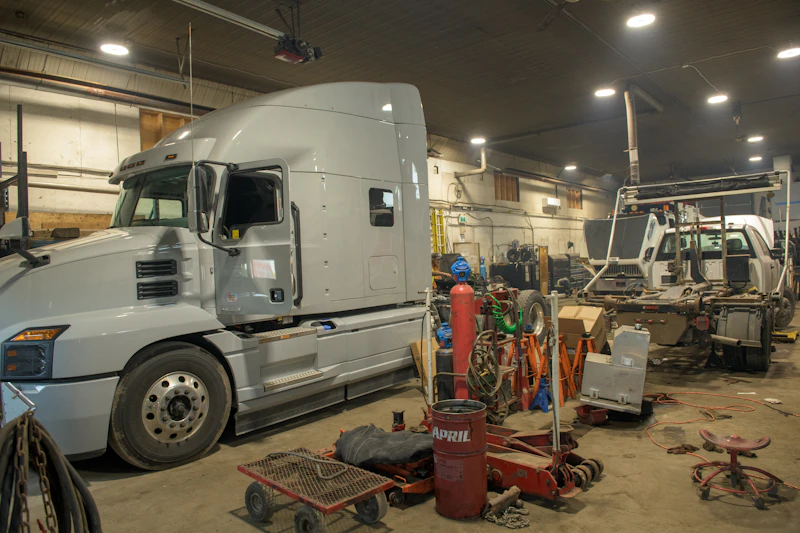Are Your Truck’s Brakes Safe? How to Tell Before It’s Too Late

If you’ve ever hauled a heavy load downhill and felt your truck take just a little too long to stop, your stomach probably dropped right along with your confidence in those brakes. In the world of heavy-duty trucking, brake failure isn’t just a mechanical issue—it’s a full-blown safety crisis.
Out here in Pearland, TX, where the roads can shift from wide-open freeways to stop-and-go traffic in a heartbeat, your braking system needs to be sharp, responsive, and reliable. So how can you tell if your truck’s brakes are hanging on by a thread—or holding strong?
Let’s break it down and show you how to spot trouble before it turns into catastrophe.
Why Brake Health Is Mission-Critical
When you’re commanding 80,000 pounds of steel, there’s no room for error. Your air brake system isn’t just another line item on the maintenance checklist—it’s your truck’s most vital safety mechanism. The sooner you catch issues, the less likely you are to face runaway rigs, DOT fines, or even worse—life-threatening accidents.
And remember: DOT inspections, including BIT inspections if applicable, focus heavily on brake performance. Fail that, and your rig’s off the road until it’s fixed.
Common Signs Your Brakes Need Attention
Brake issues can often go unnoticed. If you know what to look and listen for, you can catch them early and avoid disaster.
1. Longer Stopping Distances
If it takes noticeably more room to stop your truck, especially under load, it’s a red flag. Worn brake shoes, unbalanced air pressure, or a weak service chamber could be to blame.
2. Air Leaks or Audible Hissing
That faint hiss might seem harmless—but it could indicate a leaky airline or a failing diaphragm in the chamber. Both will reduce brake effectiveness, especially during repeated stops.
3. Brake Pedal Feels “Spongy”
In air brake systems, the pedal shouldn’t feel soft or sluggish. A spongy brake pedal could mean internal air leaks, poor air compression, or faulty valves.
4. Uneven Braking or Pulling
If your rig pulls to one side under braking, that’s a sign of unbalanced brake pressure or a seized slack adjuster. Not only does it increase stopping distance—it can cause control issues in wet or slick conditions.
5. Overheating or Smoking Wheels
This one’s no joke. Smoking wheels or hot hubs point to dragging brake shoes or seized S-cams. Left unchecked, that heat can warp drums or even spark a fire.
Understanding the Brake System Components
To really diagnose what’s going on, it helps to understand what parts do what. Here’s a quick breakdown of the key components in your truck’s air brake system:
- Service Chamber: Converts compressed air into mechanical force to move your brakes.
- Pushrod: Transfers force from the service chamber to the slack adjuster.
- Slack Adjuster: Adjusts the brake shoes’ distance from the drum and transmits force to the S-cam.
- S-Cam: Rotates to push the brake shoes outward against the brake drum.
- Brake Shoes & Drum: Create the friction needed to slow the wheel.
- Air Compressor & Reservoir Tanks: Supply and store air to activate the entire system.
If any one of these parts is compromised, your braking power drops like a rock.
Daily Checks to Stay Ahead of Trouble
Before you roll out of the yard, complete a quick pre-trip brake inspection. Make this checklist part of your daily routine:
- Listen for air leaks during engine startup and shutdown
- Confirm air pressure builds up to full (typically 120-135 psi)
- Test low air pressure warning system and emergency spring brakes
- Check for excessive pushrod stroke (use chalk marks if needed)
- Inspect visible brake components for wear or rust
DOT inspectors will look for this stuff—so should you.
How Often Should You Service Your Brakes?
There’s no one-size-fits-all answer, but here’s a good rule of thumb:
- Brake inspection: Every 3 months (aligns with BIT inspection timing)
- Brake shoe replacement: Every 30,000 to 70,000 miles (depending on load, terrain, and usage)
- Air dryer and compressor maintenance: Annually or per OEM spec
Driving conditions in Pearland, TX—like high humidity, salt exposure, or frequent stop-and-go—may require more frequent attention.
When to Call in the Pros
There’s only so much you can do in a parking lot. If you're seeing:
- Irregular air pressure readings
- Brake fade after just a few stops
- Worn out drums
- Any signs of spring brake failure
It’s time to call a pro like Saviors Repair. With diagnostic tools and expert techs, we’ll pinpoint issues fast and replace worn parts before they become dangerous liabilities.
DOT Brake Compliance—Stay Ahead
Texas law and federal DOT regulations require all commercial vehicles to meet strict brake standards. Here’s what inspectors often check:
- Pushrod travel distance
- Drum condition
- Air pressure retention under static conditions
- Parking brake functionality
- Evidence of air leaks
Staying compliant isn’t just about avoiding citations—it’s about protecting your drivers and everyone else on the road.
Learn More
By learning the warning signs, inspecting your system regularly, and acting quickly when issues arise, you can stay ahead of costly repairs and major safety risks.
And if you’re in Pearland, TX and need expert brake inspection or repair, Saviors Repair has your back. From full air brake diagnostics to component replacement, we’ll make sure your truck can stop on a dime—every time.


.webp)
.webp)